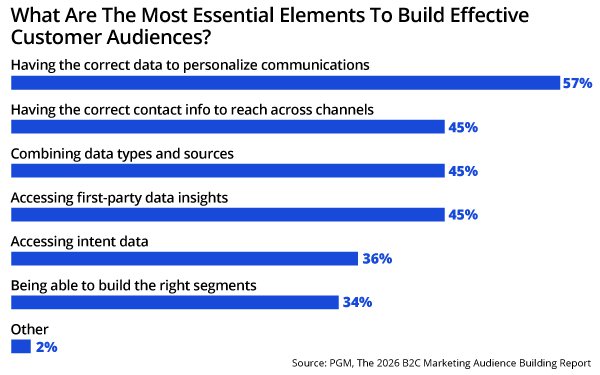
B2C marketers are still plagued by
challenges in managing data across sources.
For instance, 69% see data unification as a complex pain point. Yet 53% rate their data strategy as very effective — up from
46% last year, according to The 2026 B2C Marketing Audience Building Report, a study from Porch Group Media (PGM Solutions) conducted by Ascend2.
The biggest hurdles in building customer
audiences are:
- Having the correct data to personalize communications — 57%
- Combining data types and sources — 47%
- Having
the correct contact into to reach across channels — 46%
- Being able to build the right segments — 47%
- Accessing intent data —
38%
- Accessing first-party data insights — 32%
- Other — 4%
advertisement
advertisement
Yet marketers are using these data sources
to build their target audiences:
- Social media — 55%
- Website — 55%
- Email —
49%
- Survey — 45%
- Mobile app — 42%
- Point of sales — 37%
- CRM — 36%
- Third-party demographics — 31%
- Third-party contact — 31%
- Transactional — 30%
- Third-party behavioral or intent — 25%
The study notes that social media, email, mobile app, third-party contact data all moved up in rank from 2024.
However, survey, point of sales, CRM and transactional data have all moved down.
Email, although it has gained a point, is not relied on by brands when building their target
audiences.
In 2025, the listings are:
- Social media — 17%
- Website —
15%
- CRM — 15%
- Survey — 13%
- Transactional —
9%
- Point of sale — 9%
- Email — 7%
- Mobile app — 5%
- Third-party contact
— 4%
- Third-party demographics — 4%
- Third-party behavioral or intent — 3%
Of
the marketers polled, 63% now use first-party data, down from 65% in 2024. Third-party data usage is up to 31% from 25% last year. And, 28% are now using zero-party data, down a point YoY. The biggest
growth was in intent data reliance — from 29% to 36%.
The main benefits of significant use of first-party and intent data are:
- Improved customer
experience — 42%
- Improved ROI on advertising — 39%
- Improved targeting accuracy — 39%
- Increase
customer acquisition — 37%
- Increased customer retention — 34%
- Increased personalization of content — 34%
- Increased customer engagement — 32%
- Optimized marketing campaigns — 32%
The study concludes:
“Change is inevitable, and over-reliance on one type or source of data is risky in the unpredictability of today. The industry’s response to third-party cookie deprecation is a perfect
example of this. Many B2C companies overhauled their approach to data, investing more heavily in first-party data, alternative targeting, new measurement styles, and updated tech stacks. However,
following Google’s decision to delay or walk back its plan to fully deprecate third-party cookies, nearly half of companies (43%) have reversed or deprioritized some of these
efforts.”
PGM and Ascend2 surveyed 260 B2C marketing professionals.